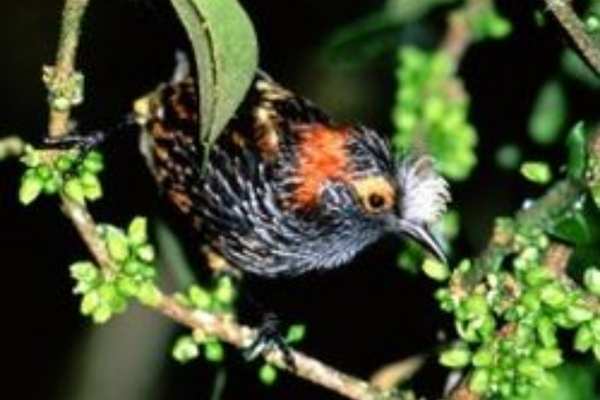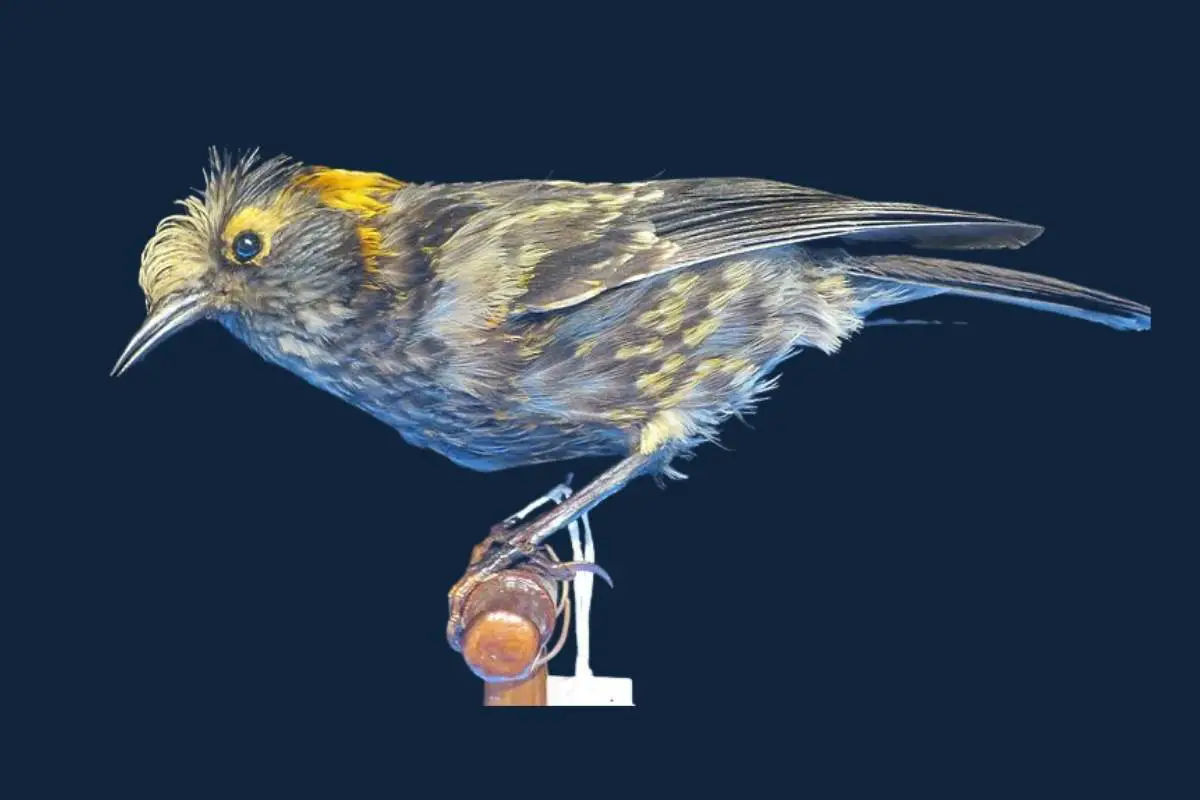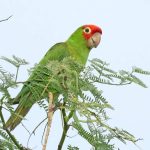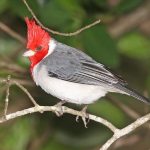Common Name: Crested Honeycreeper
Scientific Name: Palmeria dolei| Size | Diet | Range in Hawaii | Status in Hawaii |
|---|---|---|---|
| 6.5 in. - 7 in. | glean insects, fruit, and nectar from other plants | Island of Maui | critically endangered |
Only 17 of the 56 honeycreepers discovered in Hawaii have survived to this day, and the Crested honeycreeper is one of them. Crested honeycreepers are a type of bird found on Hawaii’s Maui island.
Due to their distinctive color combinations and pronounced crests on their heads, these species are among the island’s most eye-catching birds. There’s a lot to learn about this species, and we will share with you some of the things you need to know about this magnificent Hawaiian bird.
Crested honeycreeper

Scientific Name: Palmeria dolei
Appearance
These crested honeycreepers are small tropical birds that are about 7 inches and are known for the crest on their head, which is whitish gold in color. The majority of the color on this bird is black, with whitish accents along the sides.
Orange feathers can be seen on its wings, underside, and head. Their eyes are surrounded by reddish-orange feathers with a cream-colored stream.
They also have black bills and legs, as well as white at the tip of their tails. In contrast to adults, young birds lack orange feathers and are brownish-black in color.
Diet
Crested honeycreepers are small nectar and honey-sucking birds with long, pointed bills. They’re nectarivorous, feeding primarily on flower blossoms.
The majority of their diet consists of ʻōhiʻa lehua blossoms found in forest areas. When foraging for food, they’re observed hopping and running rather than flying.
These birds are also known for chasing away other honey-eating animals away from ʻōhiʻa trees to avoid competition. This bird will feed on the nectars of other plants and flowers, such as tree ohelo and Akala. They’ll also eat insects and arthropods seen on tree branches from time to time.
Behavioral traits
These native Hawaiian birds are known for their unusual sound, which can be described as a “peculiar, high-pitched” whistle. The crested honeycreeper can summon up to nine adult birds in a single tree.
This behavior is common in many bird species and is used to locate other members of the same species. Their calls are a combination of ‘whee-o, whee-o’ and low guttural sounds.
Breeding
Crested honeycreepers were observed preparing their nests during February and March. During this time, females construct nests in the branches of ohia trees. Their nests are made of twigs and are shaped like cups so that the female can fit comfortably inside.
The males also develop cloaca protuberance during the breeding season. They lay one to two eggs, which they incubate for 17 days. Both male and female adults feed the young chicks until they fledge and begin to forage on their own, which usually occurs after 3-4 weeks.
Habitat
Crested honeycreepers are a type of bird that lives in Hawaii’s mountain forests. They prefer to live in areas with a high concentration of koa and ohia lehua trees.
This magnificent bird prefers its habitat to be cool and wet, so it dwells at high elevations between 1,100 and 2,300 meters, where it frequently rains and is foggy.
Native Range
This species is found in the forests of east Maui. They were discovered at high elevations ranging from 1,300 to 2,200 m on the Haleakal Volcano’s northeastern slope.
These creepers can also be found west of the Waikamoi Drainage in the Ko’olau Forest Reserve to the Hāna Forest Reserves, on Haleakal National Park lands in the Kapahulu Valley, and southeast of Kuiki to the Manawainui Valley.
They were also discovered in the Wailau and Pelekunu valleys of Moloka’i before 1907 but weren’t able to survive in the area.
Conservation Status
The IUCN has classified this species as Critically Endangered, and it’s protected under the Federal Endangered Species Act. They were once found in many high-elevation forested areas of the islands, but their numbers have declined significantly due to habitat loss and introduced animals such as rats and other birds.
Because of their small population size and restricted range, these birds are now extremely vulnerable to extinction. They also have a low reproductive rate, laying only one to two eggs per season, which means that any population losses take a long time to recover from.
Interesting Facts
1. Their Hawaiian name is Akohekohe
The Crested Honeycreeper is also known as ‘kohekohe by the locals, after a variation of their song that includes a low guttural song that sounds like “AH-kohay-kohay.”
2. They’re one of the largest honeycreepers
The crested honeycreeper is one of the largest honeycreeper species, reaching sizes of up to 7 inches. Most honeycreepers are only between 4 and 6 inches.
3. Crested honeycreepers have an aggressive and acrobatic foraging behavior
Unlike other birds, this species doesn’t fly but rather runs from tree to tree while foraging for flower blossoms. They were also seen performing acrobatic splits and twists in order to reach the flowers. Crested honeycreepers will also chase away any rivals the birds may encounter while foraging.
4. Their plumage has an odor
The plumage of these birds has a musty, sweetish odor, which the researchers named Drepanidine odor. This odor is one of the distinguishing features of birds in the Drepanidinae subfamily.
5. Both the male and female work together to build a nest
The female serves as the nest-builder during the breeding season, while the male gathers the materials for the nest.
Frequently Asked Questions
How many Akohekohe are left?
According to the 2017 survey, the crested honeycreeper population is estimated to be 1,768 individuals (in a range of 1,100-2,500 mature individuals).
Why is the Akohekohe endangered?
Among the causes of their extinction are habitat destruction and modification, disease-carrying mosquitoes, the spread of feral pigs, and introduced predator animals such as rats, cats, and mongooses.




